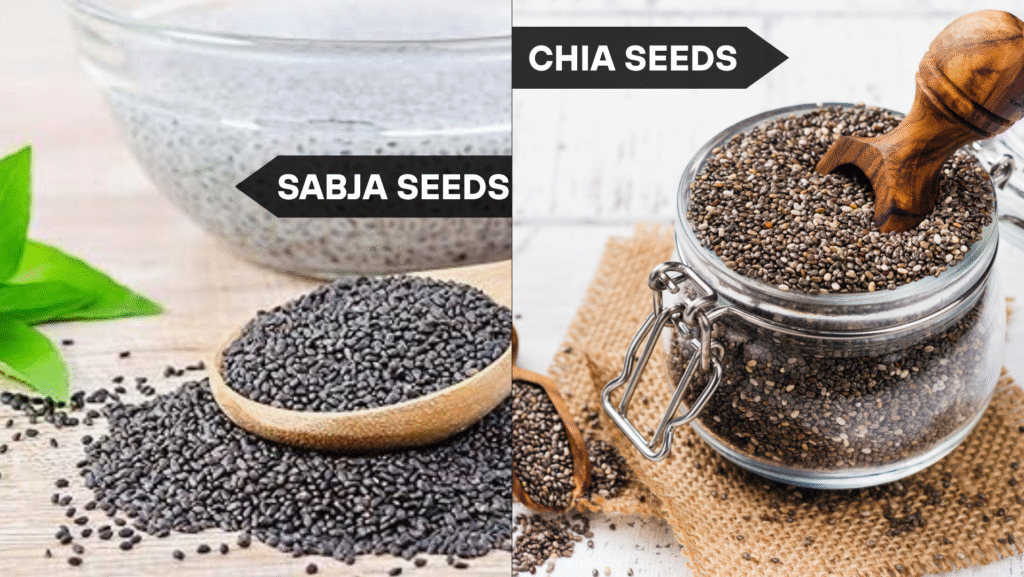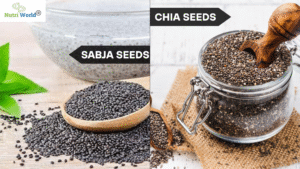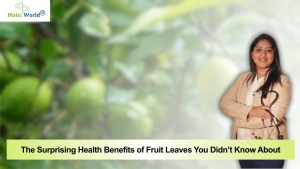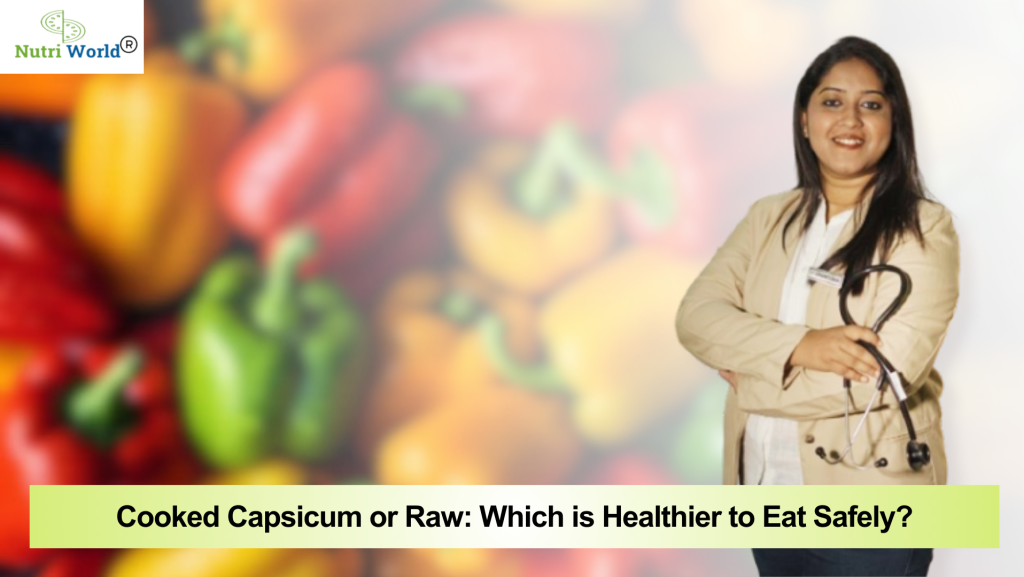When it comes to superfoods, Sabja seeds (also known as basil seeds) and chia seeds often lead the charts. These tiny seeds might look similar at first glance, but they come from different plants and offer distinct nutritional benefits. Whether you’re trying to lose weight, boost your fiber intake, or just want a nutrient-rich addition to your smoothies, understanding the difference between Sabja seeds and chia seeds is essential.
In this article, we’ll break down the differences, similarities, nutritional value, uses, and benefits of these two popular seeds to help you choose the right one for your health goals.

1. What Are Sabja Seeds?
Also called falooda seeds, Sabja seeds are derived from sweet basil. They’re mainly used in traditional Indian and Southeast Asian drinks like falooda, sharbat, and lemon water.
They have excellent cooling properties and are perfect for summer beverages. Once soaked, they form a jelly-like coating similar to chia seeds
🌱 2. What Are Chia Seeds?
Chia seeds are native to Mexico and come from the Salvia hispanica plant. A staple in the diets of Aztecs and Mayans, chia means “strength,” and rightfully so.
They’re a global superfood rich in omega-3 fatty acids, antioxidants, fiber, and plant-based protein. Unlike Sabja, chia seeds can be eaten raw, soaked, or even ground.
Nutritional Differences
🔸 Calories and Macronutrients
Chia seeds are denser in calories and fat due to their higher omega-3 and healthy fat content. If you’re aiming for weight gain or brain health, chia wins.
However, for low-calorie diets, Sabja seeds are more suitable.
🔸 Fiber Content
Both seeds are excellent sources of dietary fiber, supporting gut health, digestion, and satiety. Fiber also helps in blood sugar regulation and preventing constipation.
🔸 Protein Content
Sabja seeds slightly outperform chia in protein, making them great for vegetarians and vegans looking for a protein boost.
🔸 Omega-3 Fatty Acids
Chia seeds shine here. They are one of the richest plant-based sources of ALA (Alpha-linolenic acid), an essential omega-3 fatty acid crucial for heart and brain health.
Which One Helps in Weight Loss?
Both are useful, but in different ways:
- Sabja Seeds: Low in calories and fast-soaking, they’re great in pre-meal drinks to control hunger.
- Chia Seeds: High in fiber and fats, they keep you full longer and support metabolism.
✅ Pro Tip: Soak 1 tsp Sabja in lemon water before meals or add 1 tbsp chia to smoothies or oatmeal.
Health Benefits at a Glance
🌼 Sabja Seeds Benefits:
- Reduces body heat
- Aids digestion
- Supports weight loss
- May regulate blood sugar
- Rich in calcium and iron
🌾 Chia Seeds Benefits:
- Rich in omega-3 fatty acids
- Promotes heart and brain health
- Supports bone health
- Stabilizes blood sugar
- High in antioxidant
How to Use Sabja & Chia Seeds in Your Diet
Sabja Seeds:
- Soak 1 tsp in warm water for 10–15 mins before
- Add to:
- Detox drinks
- Lemon water
- Coconut water
- Milk-based shakes
- Herbal teas
Chia Seeds:
- Use raw, soaked, or ground.
- Add to:
- Smoothies
- Overnight oats
- Yogurt bowls
- Baked goods (like muffins, breads)
- Chia puddings
Common Myths Busted
Myth 1: Chia and Sabja are the same.
✅Fact : They’re from different plant families and differ in nutrients.
Myth 2: Chia seeds can be eaten without soaking.
✅ Fact: You can, but soaking improves digestibility and nutrient absorption.
Myth 3: Sabja seeds help in PCOS.
✅ Fact: No direct link, but their fiber and cooling effect may indirectly help hormonal balance.
Final Thoughts by a Nutritionist
Both Sabja and Chia seeds offer powerful health benefits in small quantities. Think of them as tiny nutrition bombs — easily added to daily meals, with big results over time. Your choice should depend on your personal health goals, lifestyle, and taste preferences.
ReWeWber: con3ť3tenc) over Quantťt) ť3 ke). Even 1 tb3p a da) can do Monder3 Mhen paťred Mťth a balanced dťet and actťve lťfe3t)le.

Hi, I’m Dietitian Dipanwita Saha, A Clinical Dietitian & Nutripreneur and The Founder & Director of Nutri World. I believe healthy eating should be enjoyable, balanced, and free from guilt—not about strict rules or cutting out your favorite foods. My passion lies in helping people heal their relationship with food, especially those dealing with disordered eating. If you’re looking for a supportive, judgment-free space to nourish your body and mind, I’m here to help—let’s make food feel good again.








